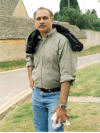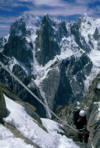|
|
the-south-asian.com July / August 2006 |
|
|||
|
August/September Contents
Sufis
- wisdom against 50
years of mountain Heritage cities:
Cotton - the fibre of
|
|
||||
|
Page
3 of 7
50 years of Climbing –
Everest, K2, & Nanga Parbat by Salman Minhas
First published January 2004
K2 - the Great Mountain
PIA
used to have an “Air Safari” about 10 years ago, which has been
discontinued. See an account of this in: http://www.the-south-asian.com/Nov2000/Karakoraair_safari1.htm For runners, there used to be a Skardu Marathon that was organized by Sylvain Saudan of Chamonix, France. It follows a route that the jeep track now takes. One goes up the Shigar valley, north to Askole.
Karakoram Weather – Chamber of Horrors.
The Catch-22 of
K2 and Nanga Parbat
climbing:
Up to about 6000 meters
K2 is mostly rock. After that it turns into a sea of snow. The Abruzzi
ridge has been described by one climber as This, together with the erratic, rather schizophrenic weather with three major weather systems intersecting/ affecting it [Monsoons, Central Asian and Tibetan anti-cyclones/high pressure, plus the Jet Stream], and the geological anomalies of three major earth plates colliding nearby [ see Nanga Parbat Geology above ] has made it the most difficult mountain to climb.
Basically in the winter
and spring, the Karakoram area is affected by large-scale weather systems.
These originate from the Mediterranean or from the area of the Caspian
Sea-Central Asia. Storms occur in the pre-monsoon season and then again
from monsoon systems during the summer. Even in the summer, some of the
higher-level snow/rain originates from westerly systems. In winter, the
Tibetan plateau, at an altitude of 15,000 feet, induces
anticyclone/high
pressure flows that move out from Tibet towards western Pacific, Indochina
Peninsula, Australia, and southeastern Africa. In summer the reverse
happens. Cyclonic flows/low pressure converges to the Tibet region along the
reversed paths. In
addition weather in the mountains is also influenced by elevation, valley
orientation, aspect plus slope, and the height and number of upwind barriers
to the airflow. The resulting impact of these Karakoram weather systems on
climbing is summed up in a simple single concept – what is called the
Chamber of Horrors.
Both Nanga Parbat and K2
are considered more difficult to climb with their combination of weird
weather and difficult climbing approaches. Climbers are offered a catch -22
situation -- Death by getting blown off the mountain [as did Alison
Hargreaves – the Scottish woman climber] - @ 140 + mph, or death by
getting buried in an avalanche. There are few places where both wind speeds
and humidity are low, and more importantly, there is really no previous
history/pattern present. These brief, low/low situations occur early in the
summer season, in the middle, and later on as well. On Everest,
there are small
pockets of good weather in end-May for the spring expeditions and in
early-October for the fall expeditions - the monsoonal transition, when it
happens, creates a weather window. It is a fact that most K2 climbers get
killed descending the mountain. To understand the winter Karakoram weather
read
www.the-south-asian.com June 2002 for a full account of Zawada’s
abortive K2 winter ascent when their expedition was snowed in for full two
weeks.
“The frosty winds blowing from Concordia in the south caused many a problem
for us in the Base Camp. Meanwhile on the top of K2, winds were blowing from
the West and the
North West. We
started towards the Abruzzi Ridge on December 27 ... Our progress was
interrupted by persistent spells of appalling weather. Hurricanes were
accompanied by thick clouds and heavy snow. During our winter climb of
Everest, the winds had been blowing constantly but at least there had been a
blue sky above and this made a tremendous difference to us." -
K2
in Winter - Mountain Madness
Zawada became
the pioneer of Everest in winter -1987-88. Read the article in:
http://www.the-south-asian.com/June2002/K2_Expedition.htm
by Andrzej Zawada – “A Winter expedition to K2” – 1997-98]. Although
Zawada was unsuccessful in 1997-98 winter K2 expedition, his account in this
article is instructive:
“The pressure of desperate situations and dangerous conditions reveal a
person’s real character. The weak blame others …failure is very bitter but
it makes you reflect more on the situation than the euphoric state of
victory …it is good that the mountains still teach humility to human beings
particularly in this day and age when people think that we can conquer
nature completely. K2
in winter still remains a challenge.” Krzystof Wielicki has carried on the work of winter expeditions with another winter expedition in 2003. Zawada is no longer there; he passed away a few years ago. Wielcki set a new winter altitude record -7630 meters. In 1987 under Zawada they reached 7100 meters. Krzysztof Wielicki [born on January 5, 1950] in Szklarka Przygodzicka (Wielkopolska) to a teacher’s family is quite a character. Learning independence as a Boy Scout, he went on to study electronic engineering at the Wroclaw School of Engineering. He has completed 8000-meter summits 15 times. He climbed Nanga Parbat solo. During his first climb he fractured 3 lumbar vertebrae. Soon after this, to attend his brother’s marriage, he escaped from the hospital and cut his plaster corset with the help of some friends, just so that his mother would not stop his climbing. Later he got his certificate of climbing without the authorities knowing about his accident. He climbed the Tatras, The Hindukush, the Pamirs, the Alps, the Cuacasus, and fell again, getting his head stitched in the process. A member of the “Solidarity “movement, he went to Alaska working on gutting fish, where he made about $1500 - enough for him to build a small house. As a real working class hero, he worked as a painter, then in a Fiat car assembly plant. He has a son and two daughters. His story is a fascinating account of guts and glory and “those who dare win” type commando thriller. A rock avalanche shortened his spine in the Garwhal Mountains, India. Here is a Weilicki view:
“Do you have to justify
for having a passion? You can change your hobbies, not your passion. With
time, it fills all spheres of your life.”
His comments on Wanda
Rutkiewicz:
For further reading, an account of Weilicki’s life and his praise of Wanda Rutkiewicz is given in: http://www.russianclimb.com/k2/interview.html
Mountains and Men - Introduction & Early Surveyors Nanga Parbat - the Killer Mountain K2 - the most difficult mountain to climb Women on Nanga Parbat, K2, and Mt.Everest
|
|||||
|
Copyright © 2000 - 2006 [the-south-asian.com]. Intellectual Property. All rights reserved. |
|||||







